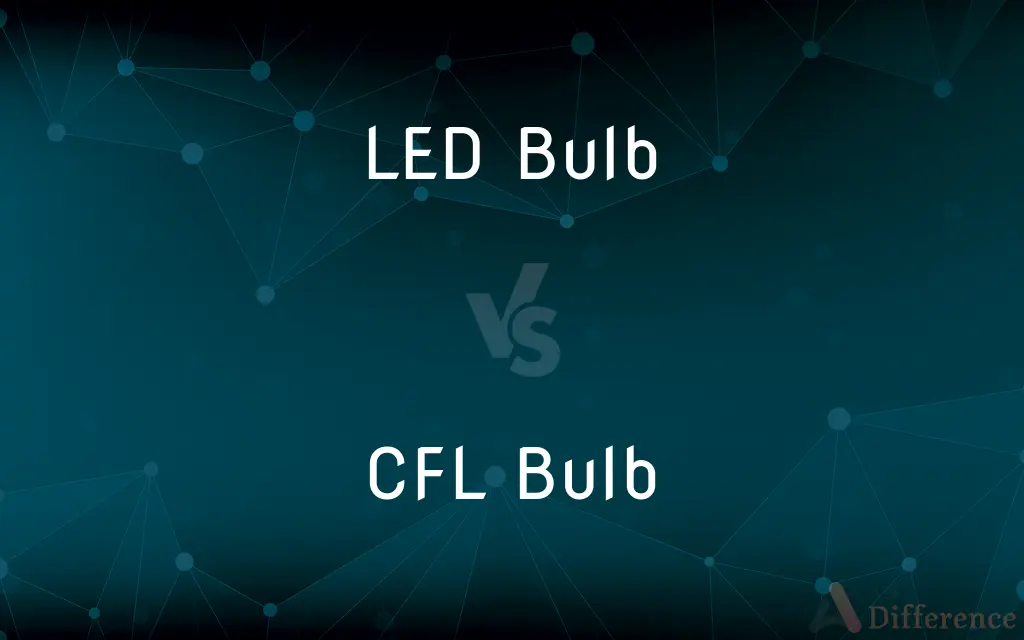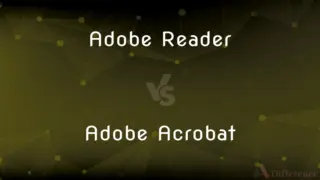LED Bulb vs. CFL Bulb — What's the Difference?
By Fiza Rafique & Maham Liaqat — Published on December 7, 2024
LED bulbs are energy-efficient with a long lifespan, while CFL bulbs are cost-effective but have a shorter lifespan and contain mercury.

Difference Between LED Bulb and CFL Bulb
Table of Contents
ADVERTISEMENT
Key Differences
LED bulbs use light-emitting diodes to produce light, known for their energy efficiency and longevity. They consume less power and have a lifespan of up to 25,000 hours. On the other hand, CFL (Compact Fluorescent Lamp) bulbs generate light through the excitation of mercury vapor, offering a balance between energy efficiency and cost. They typically last about 8,000 hours but contain mercury, requiring careful disposal.
While LED bulbs are more expensive initially, their lower energy consumption and longer lifespan mean they can be more cost-effective in the long run. CFL bulbs, however, are cheaper to purchase but may lead to higher overall costs due to shorter lifespan and the need for more frequent replacements.
LED bulbs offer immediate illumination with a wide range of color temperatures, making them versatile for various applications. CFL bulbs, however, may require a brief warm-up period before reaching full brightness and generally have a more limited color temperature range.
LED technology is more durable and less susceptible to breakage, making them ideal for various settings, including those that require frequent on-off cycling. CFL bulbs are more fragile and their lifespan can be significantly reduced by frequent on-off cycling, making them less suited for such applications.
Environmentally, LED bulbs have a smaller carbon footprint over their lifetime due to their energy efficiency and lack of hazardous materials. CFL bulbs, while energy-efficient, contain mercury, posing environmental risks if not disposed of properly.
ADVERTISEMENT
Comparison Chart
Lifespan
Up to 25,000 hours
Up to 8,000 hours
Energy Efficiency
High
Moderate
Initial Cost
Higher
Lower
Light Emission
Immediate
Requires warm-up
Environmental Impact
Low (No mercury)
Higher (Contains mercury)
Compare with Definitions
LED Bulb
LED bulbs are known for their resistance to breakage and damage.
The LED bulb remained intact after being dropped.
CFL Bulb
A lighting option that provides a balance between upfront cost and energy efficiency.
CFL bulbs are chosen for their affordable price and decent energy savings.
LED Bulb
A lighting device that uses light-emitting diodes to provide illumination.
LED bulbs are popular in households for their low energy consumption.
CFL Bulb
An aspect of CFL bulbs that requires careful disposal due to the presence of mercury.
Dispose of broken CFL bulbs at designated recycling centers.
LED Bulb
Refers to the minimal environmental impact of LED bulbs, mainly due to the absence of mercury.
Opting for LED bulbs is a step towards greener living.
CFL Bulb
Indicates the relatively shorter operational life of CFL bulbs compared to LEDs.
The CFL bulb needed replacement after 8,000 hours.
LED Bulb
An attribute of LED bulbs, signifying their ability to last many years without needing replacement.
Many choose LED bulbs for their 25,000-hour lifespan.
CFL Bulb
The period required for CFL bulbs to reach full brightness.
The CFL bulb gradually brightened over a few minutes.
LED Bulb
The ability of LED bulbs to provide full brightness instantly without any warm-up time.
The LED bulb lit up the room immediately after switching on.
CFL Bulb
Describes the susceptibility of CFL bulbs to damage and breakage.
The CFL bulb shattered when it was accidentally knocked over.
Common Curiosities
Do CFL bulbs require special disposal methods?
Yes, due to the mercury content, CFL bulbs should be disposed of at designated recycling centers.
Why do LED bulbs have a higher initial cost than CFL bulbs?
The technology behind LED bulbs is more advanced, contributing to their higher initial cost but lower long-term expenses.
What is the main difference between LED and CFL bulbs?
LED bulbs use light-emitting diodes and are more energy-efficient with a longer lifespan, whereas CFL bulbs use mercury vapor to produce light, are less expensive upfront, but contain mercury.
Can LED and CFL bulbs be used interchangeably?
While both can fit in standard light fixtures, they differ in performance, energy efficiency, and environmental impact.
Do LED bulbs work well in outdoor conditions?
Yes, LED bulbs are well-suited for outdoor conditions due to their durability and performance in various temperatures.
How do the lifespans of LED and CFL bulbs compare?
LED bulbs have a longer lifespan, typically up to 25,000 hours, compared to CFL bulbs' 8,000 hours.
Are there any health risks associated with using CFL bulbs?
The main health risk is related to mercury exposure if a CFL bulb breaks, necessitating careful cleanup and disposal.
Is there a significant energy consumption difference between LED and CFL bulbs?
Yes, LED bulbs are generally more energy-efficient than CFL bulbs.
Are LED bulbs more environmentally friendly than CFL bulbs?
Yes, LED bulbs are more environmentally friendly due to their higher energy efficiency and lack of mercury.
Can the light quality of LED bulbs match that of CFL bulbs?
LED bulbs offer a wide range of color temperatures and can match or exceed the light quality of CFL bulbs.
Can the mercury in CFL bulbs contaminate the environment?
If not disposed of properly, the mercury in CFL bulbs can pose environmental and health risks.
How does frequent on-off cycling affect CFL and LED bulbs?
Frequent on-off cycling reduces the lifespan of CFL bulbs more significantly than LED bulbs.
Why do CFL bulbs take time to reach full brightness?
CFL bulbs require a warm-up time for the mercury vapor inside to become fully excited and produce maximum light output.
Are LED bulbs suitable for all types of fixtures?
While LED bulbs are versatile, some fixtures may require specific types of LEDs for optimal performance.
How can consumers choose between LED and CFL bulbs?
Consumers should consider factors like energy efficiency, lifespan, environmental impact, and total cost of ownership.
Share Your Discovery

Previous Comparison
Kosher Salt vs. Regular Salt
Next Comparison
Administrative Assistant vs. SecretaryAuthor Spotlight
Written by
Fiza RafiqueFiza Rafique is a skilled content writer at AskDifference.com, where she meticulously refines and enhances written pieces. Drawing from her vast editorial expertise, Fiza ensures clarity, accuracy, and precision in every article. Passionate about language, she continually seeks to elevate the quality of content for readers worldwide.
Co-written by
Maham Liaqat











































